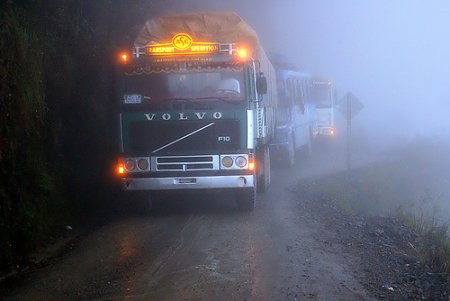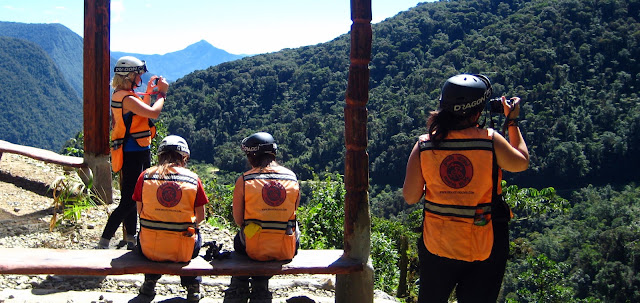| That´s me in the poncho. OK just kidding, this is from Google. But it´s the same road. |
Ok, so maybe signing up to bike down the ¨World Most Dangerous Road¨ sounds a little... stupid. I didn´t feel much better when I asked the sales woman when the last injury was.
¨Two weeks ago. A couple of guys crashed into each other. One broke his collarbone and the other broke his arm.¨
Oh.
¨And the last car crash happened then too. A taxi ran off the road and 3 people died.¨
Wonderful.
But, hear me out. Here was my logic. You are on a mountain bike. Most of the traffic takes the new road. The road is about 10 feet wide. That is plenty wide for a mountain bike. It is risky. But it is a risk that you can control. Speed is what kills people. I told myself I just would just go really, really slowly.
For decades the La Paz - Yolosa road was dubbed ¨The World´s Most Dangerous Road.¨ On average, 300 people a year died when their vehicles disappeared into the abyss below. Even today, you can see crosses marking the major accidents (e.g., when buses carrying 80 people would vanish.)
What made it the most dangerous (or more correctly, most deadly), was the terrifying combination of traffic, idiotic driving and terrible weather. It is the only road connecting La Paz (population approx. 1 million) to several cities in the Amazon basin (population approx. 1 million). If you wanted to deliver Coke, you had to go over the road. The road is scary on a bike or in a car. It is suicide in an 18 wheeler.
 |
| Christ. (Also from Google). There aren´t any trucks on the road anymore - they all take the new highway. |
As first one - and then a second impatient motorist - overtook our car on the ravine side of the road, my own driver - who hardly ever spoke a word and only then in his native Aymara - intoned loudly, eerily and in perfect English..."You will die." - BBC
Then finally there is the rainy season. A wet front rolls in, there is fog, and it rains. It so steep, and so wet, that inevitably the ground gives way and -poof- there goes the road.
There are stories told of truckers too tired - or too afraid - to continue, who pull over for the night, hoping to see out an Andean storm. But they have parked too close to the edge. And as they sleep in their cabs, the road is washed away around them.
As incredible as it sounds, there are guides who make careers out of biking the road. Our Bolivian guide had ridden the road seven hundred times. Maybe my risk assessment was more sane than I thought.
As a side note, almost all insurance companies cover accidents on the road. Why? Because it is a public road and riding a bicycle on public roads is not considered an extreme sport. Loophole?
Although there were parts that were intense, our group made it down without a scratch. The road is wide enough, 10 feet at the most narrow parts, that if you go carefully there is plenty of space to work with. The ride is also spit into nearly a dozen stages, so your guide can explain what the hazards are in the next stage and your fingers can rest from gripping the brakes. A great time, even if it is surreal having your guide describe all the vehicles that went over the edge one section at a time...
This episode from Top Gear rings true:
And since everyone loves Top Gear... some more from Bolivia:
And here are some original shots of the road:
 |
| Almost perpendicular cliff at the edge of the road. It is a long way down. |
 |
| The road hugs the side of the mountain for about 50km as it drops about 10,000 feet. |
 |
| Another gut-wrenching perspective. |
 |
| Our guide - mountain biking around the world and a little short on cash, so he is leading these trips until he can leave Bolivia. |
 |
| All the safety gear makes us a look like clown on bicycles. |
 |
| The new, less deadly, road to Coroico. Full two lanes, asphalt, and guardrails. 20 years in the making and funded by international aid agencies. |
No comments:
Post a Comment